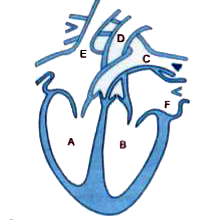In our heart, al the four chambers are completely partitioned. It resultes in non - mixing of oxygenated blood with deoxygenated blood. Explain the double circulation related to it.
Text Solution
1. Circulation of the blood was first descibed by William Harvey ( 1628). There are two types of blood circulation in vertebrates, single circulation and double circulation.
2. The blood circulates twice through the heart first on the right side them on the left side to complete one cardiac cycle. The complete double blood circulation is more prominent in mammals because of the complete partition of all the chambers (Auricles and verntricles ) in the heart.
3. In systemic circulation, the oxygenated blood entering the aorta from the left ventricle is carried by a network of arteries, arterioles and capillaries to the tissues.
4. The deoxygenated blood from the tissue in vertebrates, single circulation and double circulation The blood circulates twice through the heart first on the right then on the left side to complete o cardiac cycle.

5. The complete double blood circulation is more prominent in mammals because of the complete partition of all the chambers (Auriles and ventricles in the heart.
6. In systemic circulation, the oxygenated blood entering the aorta from the left ventricle is carried by a network of arteries, arterioles and capillaries to the tissues.
7. The deoxygenated blood from the tissue capillary walls and can acumulate in the tissues.
8. This increases the diffusion distance and reduces the efficiency of the gas exchange.
9. In contrast high pressure is equired to force blood through the long systemic circuits. Hence the arteries close to the heart have increased pressure than the arteries away from the heart.
10. Completely separated circuits (pulmonary and systemic) allow these two different demands to be met with.
|
Similar Questions
Knowledge Check
Mixing of oxygenated and deoxygenated blood occurs in the heart of
ABirdBCrocodileCRabbitDFrogMixing of oxygenated and deoxygenated blood occurs in the ventricle of
AScoliodonBFrogCRabbitDPigeonWhich animal has most mixing of oxygenated and deoxygenated blood in the ventricles?
AScoliodonBRabbitCFrogDNone of these
In which chamber of heart is oxygenated and deoxygenated blood found?
View SolutionIn which chamber of heart is oxygenated and deoxygenated blood found?
View Solution(i) Identify any two parts from the above diagram which carry oxygenated and deoxygenated blood.
(ii) Explain the process of double circulation with the help of a flow chart .

View Solution(i) Identify any two parts from the above diagram which carry oxygenated and deoxygenated blood.
(ii) Explain the process of double circulation with the help of a flow chart.

View SolutionGive the causes of the following :
(a) Heart sounds
(b) Non-mixing of deoxygenated and oxygenated blood in the mammalian heart.
View Solution
